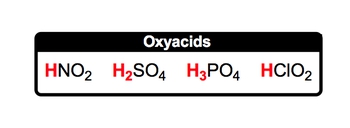An acid is defined as a covalent compound that typically begins with a hydrogen ion (H+), which is also known as a hydronium ion. Covalent compounds are formed exclusively from nonmetals bonded together. To identify nonmetals, one can refer to the periodic table and the classifications of elements within it.
Common examples of acids include HCl (hydrochloric acid), HNO2 (nitrous acid), and H2SO4 (sulfuric acid). All these acids are covalent, as they consist of nonmetals and start with hydrogen, which is a characteristic feature of acids. Some acids, like HCl, are relatively simple, while others, such as H3PO4 (phosphoric acid), are more complex.
It is important to note that while most acids begin with a hydrogen ion, there are exceptions. A notable example is acetic acid, which can be represented in two ways: one aligns with the definition, starting with hydrogen, while the other is written as CH3COOH, where the hydrogen ion appears at the end. Despite this variation, acetic acid remains classified as an acid.
Understanding the basic structure of acids sets the foundation for exploring the different types of acids and the rules for naming them, which will be discussed further in subsequent materials.


